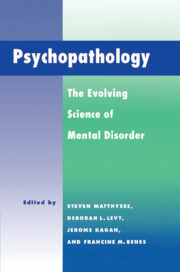Book contents
- Frontmatter
- Contents
- List of Contributors
- Preface
- Brain mechanisms
- Development
- 7 Editor's introduction: Methods in the developmental study of madness
- 8 Developmental psychopathology: From attribution toward information
- Comments on Sheldon H. White's chapter
- 9 A paradoxical partnership: Some historical and contemporary referents linking adult schizophreniform disorder and resilient children under stress
- 10 A look at the evolution of developmental models of schizophrenia
- 11 Developmental theory: Lessons from the study of risk and psychopathology
- 12 The return of the ancients: On temperament and development
- Thinking
- Genetics
- Response and reflections
- Author index
- Subject index
12 - The return of the ancients: On temperament and development
Published online by Cambridge University Press: 04 May 2010
- Frontmatter
- Contents
- List of Contributors
- Preface
- Brain mechanisms
- Development
- 7 Editor's introduction: Methods in the developmental study of madness
- 8 Developmental psychopathology: From attribution toward information
- Comments on Sheldon H. White's chapter
- 9 A paradoxical partnership: Some historical and contemporary referents linking adult schizophreniform disorder and resilient children under stress
- 10 A look at the evolution of developmental models of schizophrenia
- 11 Developmental theory: Lessons from the study of risk and psychopathology
- 12 The return of the ancients: On temperament and development
- Thinking
- Genetics
- Response and reflections
- Author index
- Subject index
Summary
Deviant human behavior, like a Halloween mask, creates a state of uncertainty in the viewer because it is a transformation on what is so totally familiar. The apathy of the depressive and the incoherence of the schizophrenic are upsetting and provoke, along with empathy, attempts at explanation derived from the deepest philosophical assumptions of the society. Although the heart of this chapter is a discussion of the relation of contemporary research on temperament to psychopathology, a brief synopsis of Western explanations of psychopathology is relevant for temperamental interpretations have cycled in popularity over the last two millennia.
The student of intellectual history reflexively begins with Plato who, on this issue, regarded abnormal behavior as a sign of failure to understand the moral imperatives of Greek society. Chronic inability to control the moods of envy and hostility, which were serious deviations from Athenian ethical standards, revealed a lapsed soul and a vulnerability to melancholy, mania, or delusions. Aristotle replaced this moral evaluation of symptoms with an empirical and ethically neutral biological description that lasted for almost a thousand years. In the most popular form, elaborated in the second century by Galen, each person possessed a profile of the four humors of blood, phlegm, and yellow and black bile, the bodily analogues of air, water, fire, and earth, which generated a physiological pattern combining a cold–warm and a dry–moist dimension.
- Type
- Chapter
- Information
- PsychopathologyThe Evolving Science of Mental Disorder, pp. 285 - 298Publisher: Cambridge University PressPrint publication year: 1996



